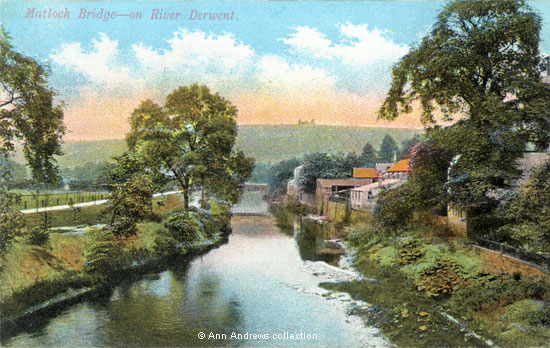|
Images Index> 20th & 21st Century, Matlock> This page |
| Matlock: The Derwent, about 1910, & the Sewerage Scheme |
| Matlock : Twentieth Century Photographs, Postcards, Engravings & Etchings |
|
|
||||||||||||
It may have been receiving attention, but nothing was decided for some time. In 1909 the two Matlock Councils, Matlock and Matlock Bath, faced summonses. Derbyshire County Council asked for penalties against them for not having obeyed a previous Court Order in which the defendants undertook to carry out sewerage schemes. Mr. Bailey appeared for the County Council, Mr. F. C. Lymn for the Matlock Bath Council, and Mr. Sleigh for Matlock Council. It was stated that the last Court order had expired in 1907, but since then a scheme had been prepared that both councils had agreed to join. The estimated cost was £45,000, of which Matlock Bath would pay £10,000. It was claimed that plans for the scheme were ready for presentation to the Local Government Board[2]. Matlock Urban District Council granted an extension for the receipt of tenders for the work in 1912[3]. At the beginning of the First World War advertisements appeared in the local papers wanting miners to blast rocks in a sewer tunnel[4]. Then in late 1915 one of the Local Government Board inspectors visited Matlock Town Hall to consider the Council's request for further powers to raise loans so that they could complete the sewerage scheme. They needed a further £12,000. Matlock Council's chairman, Mr. D. M. Wildgoose, attended the meeting together with the Clerk of the Council, Mr. R. Taylor, and Matlock Bath Council. Also represented were Bakewell Rural District Council, Belper Rural District Council, and the Cromford Parish Council. Mr. Taylor assured the meeting that the other Councils were not being asked to pay[5]. The scheme was not finished until 1925, having taken fifteen years to complete[6]. And it was around twenty eight years since a scheme had been first suggested. |
|||||||||||||
|
1. Matlock: The Derwent". One of the "Celesque" Series, published by the Photochrome Co. Ltd, London and Tunbridge Wells (F.38512). The card is unused so the date of publication only approximate, although another card was posted in 1919. Image re-scanned 2014. 2. "Matlock Bridge - on River Derwent". Jarrolds, Printers, Norwich. Not posted. Postcards in the collection of, provided by and © Ann Andrews. Information researched, written by and © Ann Andrews. Intended for personal use only. |
|||||||||||||
References (coloured links are to transcripts or more information elsewhere on this web site): [1] "Derbyshire Times and Chesterfield
Herald", Saturday 31 May 1902. River Pollution at Matlock. |





